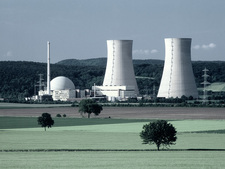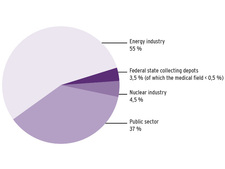Origin of radioactive waste
- The disposal of radioactive waste is a national task.
- According to the plan-approval decision, 303,000 cubic metres of radioactive waste with negligible heat generation can be disposed of in the Konrad mine.
- The costs for the management of the waste are borne according to the polluter pays principle.

![]() Sites of German nuclear power plants and research reactors
Sites of German nuclear power plants and research reactors
According to the plan-approval decision, 303,000 cubic metres of radioactive waste with negligible heat generation (low-level and intermediate-level radioactive waste) can be disposed of in the Konrad mine. That is about 50 per cent of all German radioactive waste. It includes only about 1 per cent of the total activity, however.
As set out in the international "Joint Convention on the Safety of Spent Fuel Management and on the Safety of Radioactive Waste Management", radioactive waste must not be disposed of in other countries but must be disposed of in its own country of origin. Germany has become party to this Joint Convention. Radioactive waste disposal is thus a national task.
Disposal in deep formations of the earth's crust
In Germany, strict legal regulations in terms of radioactive waste handling and its disposal are in effect. Therefore and in order for following generations not to be burdened with relics, the federal government has decided to dispose of radioactive waste in "deep geological formations" ultimately, i.e. permanently and free of maintenance. The Konrad mine in Salzgitter provides favourable conditions for being used as repository for radioactive waste with negligible heat generation.
Two categories of radioactive waste
In Germany, one distinguishes between two types of radioactive waste: "heat-generating waste" and "waste with negligible heat generation". At the international level one distinguishes between low-level, intermediate-level and high-level radioactive waste. Waste with negligible heat generation is comparable with low-level and partially with intermediate-level radioactive waste; heat-generating waste comprises high-level and partially intermediate-level radioactive waste.
Germany is among the few countries that have decided to dispose of all types of radioactive waste deep below the earth's surface.
In the Konrad repository, it is planned to dispose of solely radioactive waste with negligible heat generation, i.e. low-level and intermediate-level radioactive waste.
Waste from nuclear power plants, research centres and the medical field

![]() A major part of the radioactive waste is produced during the operation and dismantling of nuclear power plants
A major part of the radioactive waste is produced during the operation and dismantling of nuclear power plants
Radioactive waste with negligible heat generation originates e.g. from the operation and decommissioning of nuclear plants and facilities as well as from radioisotope application (small waste producers from industry, research, medicine). Among others, this includes spent plant components, contaminated tools, protective clothing, sludges, suspensions or oils and waste from research laboratories. Heat-generating radioactive waste consists of e.g. spent fuel elements or vitrified waste from reprocessing.
Volume of radioactive waste with negligible heat generation to be disposed of
Around two thirds of the radioactive waste with negligible heat generation to be disposed of in the Konrad repository originates from the operation and decommissioning of nuclear power plants and the nuclear industry, around one third from public sector bodies.

![]() Prognosis of the volume of conditioned waste with negligible heat generation until 2060 (accumulated), total volume: ca. 300,000 cubic metres (as of September 2014)
Prognosis of the volume of conditioned waste with negligible heat generation until 2060 (accumulated), total volume: ca. 300,000 cubic metres (as of September 2014)
Radioactive waste from the medical field is delivered to the respective federal state collecting depots and is thus taken to the repository, along with the other radioactive waste collected there. An estimated 7,500 cubic metres of radioactive waste will come from the eleven federal state collecting depots. The fraction of waste originating from medicine is thus very low and amounts to less than one per cent.
Until 2060, around 300,000 cubic metres of waste will be produced according to the waste prognoses.
The costs for the management of the waste are borne according to the polluter pays principle. Accordingly, the utilities currently contribute about two thirds and the public sector bodies about one third to the costs of disposal.
State of 2017.03.09

